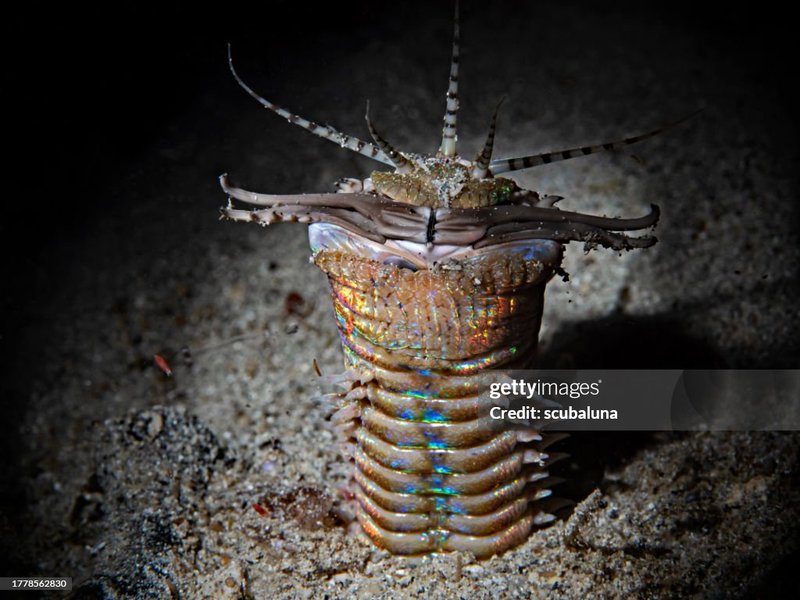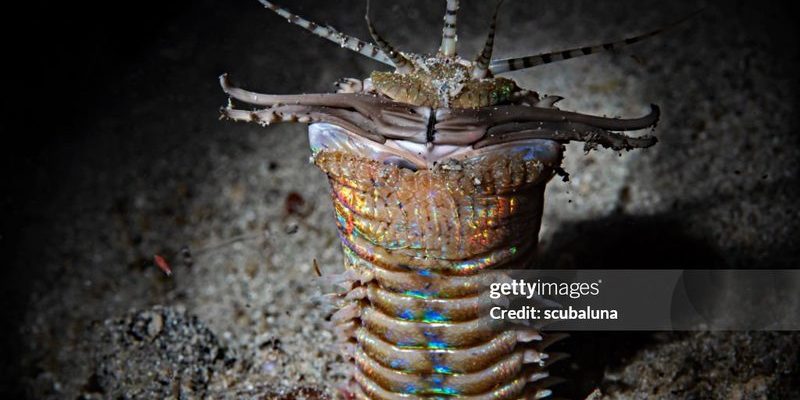
Imagine trying to sneak a peek into the secretive life of a Bobbit worm without disturbing its natural habitat. Night cameras, such as the ones from brands like Arlo or Logitech, allow researchers and curious minds to capture the amazing antics of these creatures after dark. These remote cameras are designed to work well in low light, making them perfect for underwater study. Here’s the thing: monitoring Bobbit worms at night can reveal fascinating insights into their behavior, feeding habits, and interactions, helping us understand more about these enigmatic beings.
What is a Bobbit Worm?
Bobbit worms, scientifically known as *Eunice aphroditois*, are long, segmented creatures that can grow up to ten feet in length! They are typically found in the sandy or muddy bottoms of tropical and subtropical oceans. With their impressive size and vibrant hues, these worms can easily catch your eye, but they’re truly captivating when you delve into their behavior.
You might wonder what sets them apart from other marine species. For starters, Bobbit worms are predatory. They use their long bodies to burrow into the sea floor while waiting for unsuspecting shrimp or fish to swim by. When prey comes close, they strike swiftly with their powerful jaws. This ambush technique is akin to a lion hiding in the tall grass, ready to pounce at just the right moment. Understanding this predatory behavior is key to studying marine ecosystems and food webs.
Another interesting fact is that these worms can regenerate lost segments. If they lose a part of their body, they can grow it back, similar to how some lizards can regrow their tails. This ability not only aids in their survival but also opens up intriguing questions about their biology and how they adapt to their environment.
Why Use Night Cameras for Monitoring?
You might be asking yourself, why night cameras? Well, Bobbit worms are primarily nocturnal. This means they do most of their activity at night, which can make daytime observations almost futile. By using night cameras, researchers can document their behaviors in real time without interrupting their natural habitat.
Think of it like snooping on your pet when they think no one’s watching. For instance, if you have a cat, you know how they behave differently when they’re alone versus when you’re around. Night cameras allow us to see the Bobbit worm’s true personality, capturing moments of hunting or interaction that we’d miss otherwise.
Moreover, modern night cameras come equipped with features like motion sensors and HD video quality. This means you can capture every wiggle and movement of the Bobbit worm in stunning detail. Some models even allow for remote monitoring, giving researchers the ability to sync their devices and stream video directly to their smartphones. This way, they can collect data without being physically present, which is crucial for minimizing disturbances in the habitat.
Choosing the Right Night Camera
When it comes to selecting a night camera for monitoring Bobbit worms, there are several options out there. Let’s break down some important features to consider:
- Low Light Performance: Look for cameras with good low light capabilities. Models like the Arlo Ultra or the Logitech Circle are known for their impressive night vision.
- Waterproof Rating: Since Bobbit worms live underwater, it’s essential to choose a camera that is waterproof. Check for IP ratings, as a higher rating indicates better water resistance.
- Battery Life: Long battery life is a must. You wouldn’t want to miss key moments because your camera ran out of juice!
- Motion Detection: Cameras with motion alerts can notify you whenever the Bobbit worm is active, saving time and conserving resources.
Choosing the right night camera is like picking the best tool for a job. It can make all the difference in capturing the elusive behavior of these remarkable creatures.
Setting Up Your Night Camera
Now that you’ve chosen the perfect night camera, let’s talk about how to set it up for monitoring Bobbit worms. Proper installation will ensure you get the best footage possible.
First, determine the location. You’ll want to place the camera close to where the Bobbit worm lives but far enough away not to disturb it. Think of it like setting up a picnic – you want to be close to the action but not so close that you scare off the guests.
Next, find a sturdy mount. Many night cameras come with adjustable mounts to help you secure them in place. If your camera is waterproof, make sure it’s well-protected from strong currents and potential debris.
Once you have it positioned, connect the camera to a power source if it needs one. If it’s battery-operated, make sure it’s fully charged. Now it’s time to sync the camera with your device. Most newer models have user-friendly apps that can guide you through this process—almost like following a recipe.
Finally, set your camera to record or stream at night, and you’re ready to watch the magic unfold!
Analyzing the Footage
After capturing footage of Bobbit worms using your night camera, it’s time to dive into the analysis. Reviewing the footage can be as exciting as watching a thriller movie. Here are some aspects to focus on:
- Feeding Habits: Observe how the Bobbit worm catches its prey. Does it wait patiently? Does it strike quickly? You might even notice patterns in their hunting times.
- Behavioral Interactions: Are they interacting with other marine creatures? If you spot other species, take note of how they interact with the Bobbit worm.
- Movement Patterns: Watch how the worm moves during the night. Is it more active at certain times? Understanding its activity level can provide insight into its life cycle and environmental adaptations.
By documenting these behaviors, researchers can contribute valuable knowledge to marine biology. You might catch something that no one else has seen before!
Potential Challenges and Solutions
While monitoring Bobbit worms with night cameras can be rewarding, there are some challenges to keep in mind:
One common issue is **low visibility**. If your camera struggles in very low light, you may miss out on crucial moments. To combat this, consider investing in a camera with enhanced night vision features, or look for one that allows for artificial lighting in your monitoring area.
Another challenge is potential **disruption** from water movement or other marine life. If the camera shifts due to currents, it might not capture what you’re hoping to see. Using sturdy mounts and placing your camera in calmer waters can help alleviate this issue.
Finally, if you’re monitoring in a busy area, you might capture too much unrelated action. Setting motion alerts can help filter through the noise, allowing you to focus on key times when Bobbit worms are most active.
The Importance of Monitoring Bobbit Worms
So, why does it matter that we monitor Bobbit worms? Understanding their behavior can have significant implications in marine research and conservation. Bobbit worms play a critical role in their ecosystems, acting as both predators and prey. By studying them, we can gain insights into the health of marine environments and how various species interact.
Moreover, with the increasing threats of habitat loss and climate change, monitoring these creatures can help scientists gauge the impact of these changes on ocean biodiversity. If we understand how organisms like Bobbit worms adapt or struggle, we can create better strategies for conservation efforts.
Let’s face it: the ocean is like a giant, mysterious puzzle, and every piece—including creatures like the Bobbit worm—matters. By using night cameras to study them, we’re not just satisfying our curiosity; we’re contributing to a larger understanding of our natural world.
In conclusion, monitoring Bobbit worm behavior using night cameras opens up a fascinating window into the underwater world. With the right equipment, careful setup, and a sharp eye for detail, anyone can make captivating discoveries about these unique marine creatures. So why not dive in and explore the depths of the ocean? You never know what incredible behaviors you might uncover!

